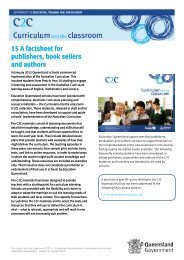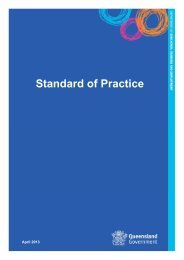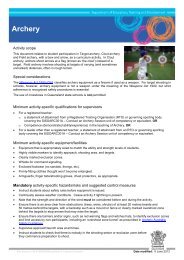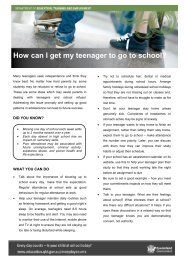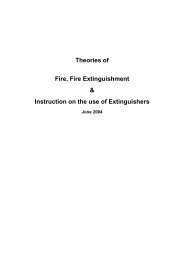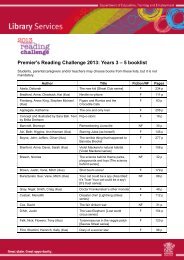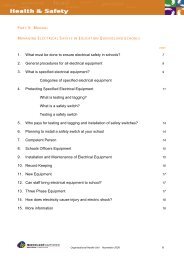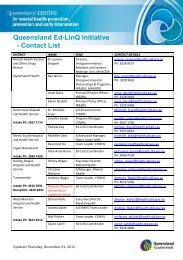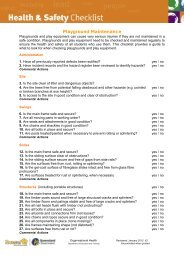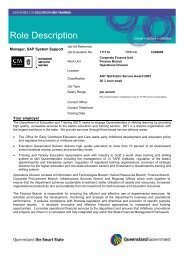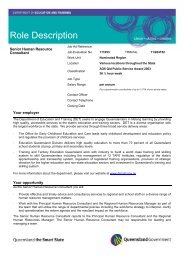Anaphylaxis guidelines for Queensland State Schools - Education ...
Anaphylaxis guidelines for Queensland State Schools - Education ...
Anaphylaxis guidelines for Queensland State Schools - Education ...
Create successful ePaper yourself
Turn your PDF publications into a flip-book with our unique Google optimized e-Paper software.
8. Roles and responsibilities of the principal<br />
The role of the principal will involve being familiar with the <strong>Anaphylaxis</strong> Guidelines <strong>for</strong> <strong>Queensland</strong> state<br />
schools in order to:<br />
• work with the school community to identify and minimise the risks associated with students diagnosed at<br />
risk of anaphylaxis and develop school-based planning <strong>for</strong> emergency responses<br />
• ensure the school has emergency first aid procedures, equipment and trained staff in place to cater <strong>for</strong><br />
potential first time (undiagnosed) episodes of anaphylaxis.<br />
8.1 Identifying the risks<br />
The key role of the principal is to:<br />
• seek in<strong>for</strong>mation from the parent about the allergies that affect the student as part of the health<br />
in<strong>for</strong>mation collected at enrolment and as part of regular health updates<br />
• discuss with the parent the capabilities of the student to recognise their own symptoms and alert others<br />
• identify the number of staff who are trained in anaphylaxis management.<br />
8.2 Minimising the risks<br />
Communicate with parents of students with anaphylaxis<br />
• Ensure that the parent supplies the school with the student’s Action Plan, completed and signed by the<br />
student’s medical practitioner, along with a personal adrenaline auto-injector <strong>for</strong> the student.<br />
• Request that the parent approves the sharing of in<strong>for</strong>mation regarding the student’s health condition<br />
with staff and relevant school volunteers.<br />
• Refer parents to Section 12 of these Guidelines to discuss the roles and responsibilities of the parent.<br />
Complete risk management planning<br />
• Consult with the parent, relevant staff, the student and relevant community members to develop a<br />
whole-of-school <strong>Anaphylaxis</strong> Risk Management Plan to assess potential risks in the student’s routine,<br />
minimise risks and reduce the risk of accidental exposure. This will ensure that students at risk of<br />
anaphylaxis are given every opportunity to participate in a full range of school activities.<br />
• Discuss with supervising staff the scenarios where there may be increased risk to the student being<br />
exposed to a potential allergen and identify strategies to reduce the risk and refer to Section 6 and<br />
Section 7 of these Guidelines to in<strong>for</strong>m discussions.<br />
Plan anaphylaxis risk minimisation strategies with school staff<br />
• Advise staff of all students with anaphylaxis who are enrolled in the school, their triggers and the risk<br />
management strategies to be implemented.<br />
• Ensure that students’ medical in<strong>for</strong>mation will only be accessed by authorised departmental employees<br />
and the in<strong>for</strong>mation will not be disclosed to any other person or body unless the parent has given<br />
consent or the Department is required or authorised by law.<br />
• Where parental permission has been given:<br />
- provide staff with in<strong>for</strong>mation about the individual student's severe allergy including copies of their<br />
Action Plan<br />
19 <strong>Anaphylaxis</strong> <strong>guidelines</strong> <strong>for</strong> <strong>Queensland</strong> state schools



